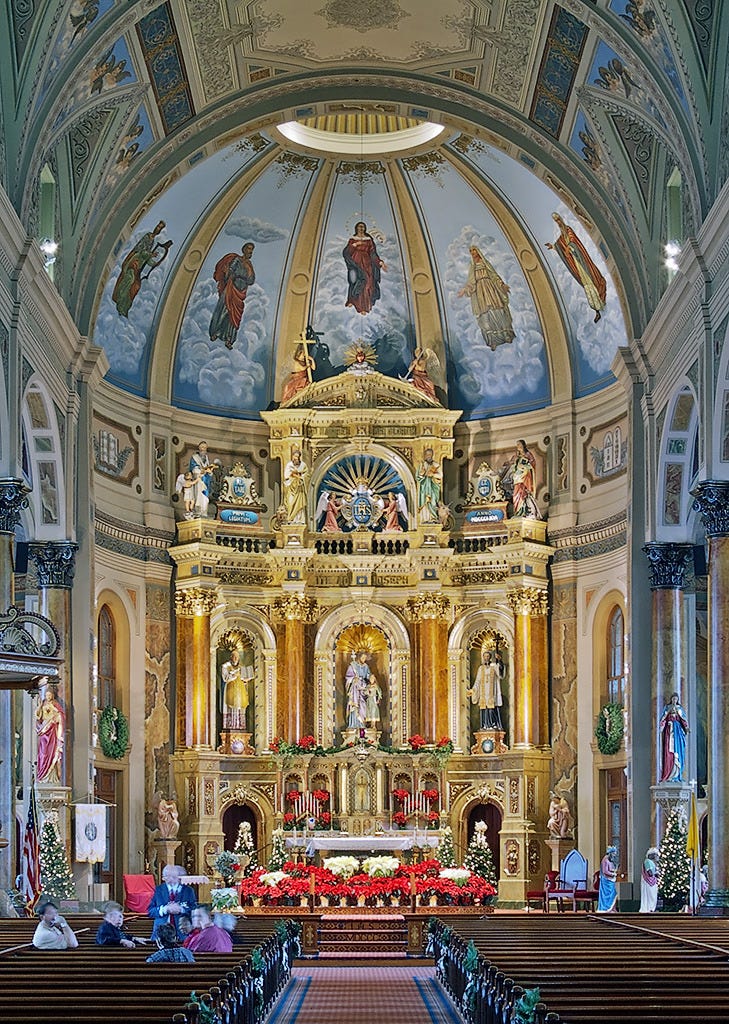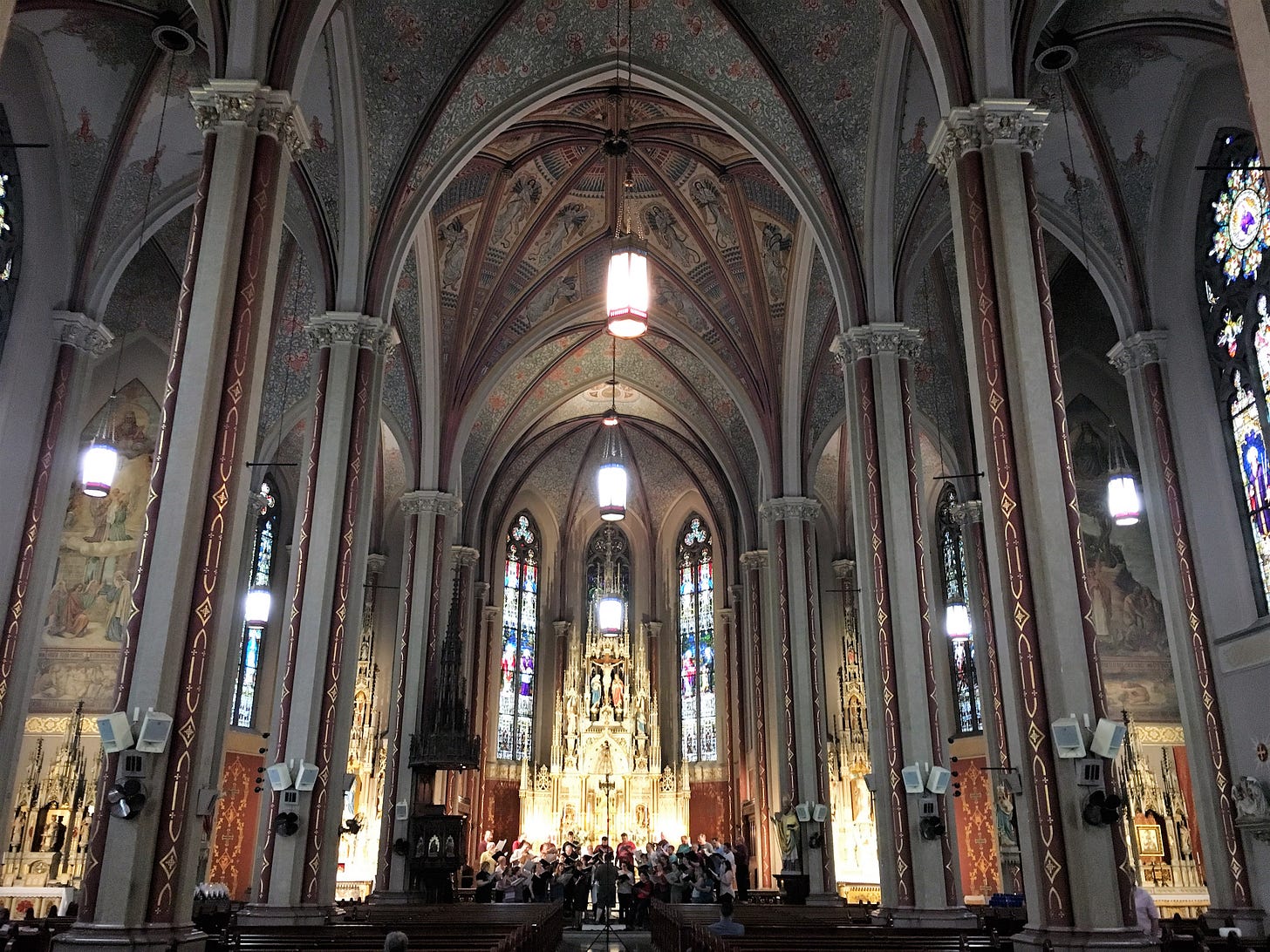Missouri at the time of the Louisiana Purchase was of course predominantly French, and the city of St. Louis was named for the Catholic Saint King Louis IX of France. However, by the mid 1800’s, St. Louis also formed the westernmost point of the “German Triangle of the West.” The flood of German immigration was great enough that by the 1830s some called the Missouri River the ‘American Rheinland!’
In terms of specific settlements, St. Louis’s travel website states:
“Some of these early German immigrants moved west up the Missouri River and founded what is now Hermann Missouri in 1837. They brought with them their knowledge of wine making and began planting vineyards. Some of the wineries those immigrants established in Hermann are still producing wine today, such as Hermannhof Winery, founded in 1852; Oak Glenn Winery, founded in 1847; Stone Hill Winery, founded in 1847. The town of Bremen, named for Bremen, Germany, located north of the city of St. Louis in what is now the Hyde Park area, was a German community that was incorporated in 1850. Bremen was annexed into the city of St. Louis in 1854. The Baden Neighborhood, which at first was called "Germantown,” also experienced a large influx of German immigrants in the 1840's and 1850's.”
The first wave of these immigrants were largely protestant, but Catholics soon followed. There was an issue however. In all three cities of the “German Triangle” many bishops were frustrated with how quickly German influence was growing in parishes and schools but also on the diocesan level. This issue reached a head with the debate over ‘Cahenslyism” in the American Catholic churches, which we will discuss another time. For now, suffice to say that Germans often faced discrimination from English-speaking residents and even bishops!
The Archdiocese of St. Louis states: “Although many of the original inhabitants had been French, St. Louis soon became a destination for Germans. Many German Catholics came to St. Louis because it offered freedom, good land and the presence of other Catholics. In fact, many Catholic immigrants found their way to St. Louis after being treated badly in other parts of the country. They faced hostility from Americans because they were German just as they had faced hostility from Germans because they were Catholic. That was less of an issue in St. Louis, and as the city grew, about half of the new settlers were Catholics. But not all spoke English. There were French-speaking Catholics whose families had built St. Louis. With German-speaking Catholics too, there weren’t always priests who spoke the language of their parish. The churches St. Mary of Victories and St. Joseph served German-speaking Catholics. Although they had thriving congregations, the German-speaking churches were not parishes in the technical sense.”
Eventually, Fr. Joseph Melcher stepped in to serve as pastor at St. Mary of Victories. A Vienna born priest originally serving North Italy, he was sent to America when he told his bishop he felt called to missionary work.
The Archdiocesan article continues: “Shortly after, he was named vicar general for German-speaking Catholics. Melcher returned to Europe to recruit other German-speaking priests. On three such trips, he recruited four priests and 12 theology students, seven of whom worked in the St. Louis Diocese after ordination. One of those recruits, Father Henry Muehlsiepen, would succeed him as vicar general and become well-known among German-speaking Catholics in St. Louis and throughout the United States… The rapid pace of immigration into the diocese both created and solved a problem. Immigrants needed places to worship, and new churches cost money. But, poor immigrants often had trouble getting loans at reasonable interest rates. In addition, many who did not speak English felt more comfortable trusting their money to representatives of the Church. (The bishop's coadjutor) went into the banking business. The "Bishop’s Bank" was at first, a small program set up by Father Ambrose Heim at St. Mary of Victories. A native of France, Heim had attended the seminary in Perryville. An immigrant himself, he encouraged his German-speaking congregation to save their money, and many chose to deposit it into his safekeeping. In 1846, Heim was transferred to the Cathedral to become a secretary, and his bank went with him. The bank not only accepted deposits and gave loans to individuals, it also provided loans to struggling parishes and paid for the expansion or renovation of religious communities. Over the years it became so successful that when St. Louis encountered an economic crisis known as the Panic of 1857, the diocese was able to loan the city money for public works.”
Thus, German Catholics can be thanked for bolstering the diocese and even saving the city’s economic prosperity even despite being looked down on at first!
St. Mary of Victories has additional history around its German origins as well. The wikipedia article states that “The church was listed on the National Register of Historic Places in 1980. It is also a consecrated Roman Catholic church; that is, the Vatican has bestowed the consecration privilege on the church itself by Pope Pius IX, performed with a specific ritual by St. Louis Archbishop Peter Richard Kenrick in 1866. The main altar of the church also has an Indulgence attached to it by Pope Leo XIII in 1896, granting temporal remission of sins at the time of death for those Catholics saying the specific prayers, and dying in the state of grace.”
Our readers may recall Pope Leo XIII’s history of friendship with German American Catholics when we discussed the Leo House German Catholic Guesthouse in NYC, created to protect and house German Catholics as they arrived through Ellis Island.
The article also states:
“The interior of St. Mary of Victories is also remarkable as the first interior in a St. Louis church whose design was based upon liturgical studies. It was developed and constructed by Max Schneiderhahn, the city's first professional church artist. Himself a German immigrant, Schneiderhahn studied at a German university and two monasteries, bringing the craftsmanship tradition of liturgical art to the St. Louis area. The altars, statuary, steepled baptismal font, communion rail, carvings and frescoes were all conceived and executed by Schneiderhahn, who also painted the Stations of the Cross.
Within its hallowed walls are also other liturgical art treasures and fixtures donated at later dates by other Roman Catholic religious orders and communities in the metro St. Louis area, particularly those of German origin, including the School Sisters of Notre Dame, the Franciscan Sisters of Mary, the Mill Hill Fathers, and the group promoting the canonization of Blessed Francis X. Seelos, C.SS.R., a Bavarian Redemptorist priest who worked with German immigrants in St. Louis, Baltimore, and New Orleans.”
The other large German catholic church in St Louis was St. Joseph Shrine, which is the site of the only Vatican-approved miracle in the midwest! A German immigrant in 1864 was injured while working in a factory and dragged himself to the church to kiss a relic, which restored his health within a few days.
Perhaps the most impressive church of German origin is the now-ICKSP-operated St. Francis De Sales Oratory. Founded by Germans in 1867 overflowing from other parishes, homilies were preached and classes taught) in German for much of this church’s history. The stained-glass windows show German saints including St. Henry, St. Boniface, St. Elizabeth, and the Blessed Herman Joseph Steinfeld. Famous German-American Catholic Fr. Frederick Holweck was rector here for a time before being appointed vicar-general for the Archdiocese!
Many Germans left St. Louis for other parts of the US in the 1950s after much persecution during both world wars. However, German cultural events do still go on, german restaurants pepper the city, and the legacy the Germans left on the city’s devout Catholic faith has not been forgotten.
Sources & Further Reading:
Missouri Rhineland - Wikipedia








